List of the Cenozoic life of Idaho
This list of the Cenozoic life of Idaho contains the various prehistoric life-forms whose fossilized remains have been reported from within the US state of Idaho and are between 66 million and 10,000 years of age.
A[]
- Abies
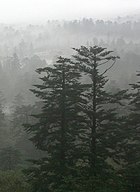 Living Abies, or fir trees
Living Abies, or fir trees- †
- †
- †
- † – type locality for species
- †
- †
- †
- Acer
- †
- †
- †
- †
- †
- †
- †
- †
- †
- †
- †
- †
- †
- †Acritohippus
- †Acritohippus isonesus
- †Aepycamelus
 Life restoration of the Miocene camel Aepycamelus, or the long-necked camel. Heinrich Harder (1920).
Life restoration of the Miocene camel Aepycamelus, or the long-necked camel. Heinrich Harder (1920). - †Aesculus
- †
- Agelaius
- †Agelaius phoeniceus
- †Agriotherium
- † – or unidentified comparable form
- †Alforjas – tentative report
- †
- † – type locality for species
- Alnus
- †
- †
- †
- †
- †
- † – type locality for species
- †
- †
- †
- †
- †Amebelodon
 Life restoration of the Miocene elephant relative Amebelodon. Margret Flinsch (1932).
Life restoration of the Miocene elephant relative Amebelodon. Margret Flinsch (1932).- † – or unidentified comparable form
- Amelanchier
- †
- †
- Anas
- †Anas platyrhynchos
- Anser
- †Anser caerulescens
- Antilocapra
- †Antilocapra americana
- Antrozous
- †Antrozous pallidus
- †Aphelops
- † – or unidentified comparable form
- †Archaeohippus
- †
- †Arctodus
- †Arctodus simus
- Ardea
- †Ardea herodias
B[]
- Baiomys
- † – type locality for species
- Betula
- †
- † – type locality for species
- †
- †
- Bibio
- † – type locality for species
- † – type locality for species
- Bison
- †
- †Bison antiquus – or unidentified comparable form
- †Bison latifrons
 Mounted fossilized skeleton of the Pleistocene Bison latifrons, also known as the giant bison or long-horned bison
Mounted fossilized skeleton of the Pleistocene Bison latifrons, also known as the giant bison or long-horned bison - †Bison priscus
- Boletina
- †Bolitophila
- † – type locality for species
- †Bombus
- † – tentative report
- Bonasa
- †Bonasa umbellus
- †Bootherium
- †Bootherium bombifrons
- †Borophagus
- †Brachycrus
 Restorative portrait of the Miocene oreodont mammal Brachycrus
Restorative portrait of the Miocene oreodont mammal Brachycrus - Brachylagus
- †Brachylagus idahoensis
- Branta
- †Branta canadensis
- Bucephala
- †
- †
C[]
- †Camelops
 Life restoration of the Pliocene-Holocene camel Camelops
Life restoration of the Pliocene-Holocene camel Camelops- †Camelops hesternus
- Camponotus
- Canis
- †Canis dirus
- †Canis ferox
- †Canis latrans
- †Canis lepophagus
- Carya
- †
- †
- †
- Castor
- †Castor californicus
- †Castor canadensis
- Ceanothus
- †
- Cedrela
- †
- † – type locality for genus
- † – type locality for species
- Cercidiphyllum
- †
- †
- Cervus
- †Cervus elaphus – or unidentified comparable form
- †Chamaecyparis
- † – type locality for species
- †
- Chen
- † – type locality for species
- †Chrysolepis
- † – type locality for species
- Ciconia – tentative report
- †Ciconia maltha
 Mounted fossilized skeleton of the Pliocene-Pleistocene Ciconia maltha, also known as the asphalt stork or La Brea stork
Mounted fossilized skeleton of the Pliocene-Pleistocene Ciconia maltha, also known as the asphalt stork or La Brea stork
- Colymbus
- Comptonia
- †
- † – tentative report
- † – tentative report
- Cornus
- †
- †
- †
- †Cosoryx
- Craigia
- †
- Crataegus
- † – type locality for species
- †
- † – type locality for species
- †Cunninghamia
- † – type locality for species
- Cygnus
- † – type locality for species
- Cynomys
- †
- †
D[]
- †Dennstaedtia
- †
- †Diceratherium
- †Diceratherium niobrarense
- †
- †
- †Dipoides
- †
- Dolichoderus
- †
- †Dromomeryx
 Fossilized horns, jaws, and limb bones of the Miocene deer relative Dromomeryx
Fossilized horns, jaws, and limb bones of the Miocene deer relative Dromomeryx - Dytiscus
- † – type locality for species
E[]
- Elaphe
- † – type locality for species
- †Elaphe vulpina
- †
- †
- †
- †
- †Epicyon
 Mounted fossilized skeleton of the Miocene bone-crushing dog Epicyon
Mounted fossilized skeleton of the Miocene bone-crushing dog Epicyon- †Epicyon haydeni
- †Equisetum
- †
- † – or unidentified comparable form
- †
- Equus
- †
- †Equus idahoensis
- †Equus scotti
- †Equus simplicidens
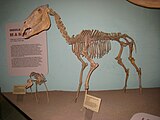 Fossilized skeleton of the Pliocene-Pleistocene horse Equus simplicidens, also known as the Hagerman horse or American zebra
Fossilized skeleton of the Pliocene-Pleistocene horse Equus simplicidens, also known as the Hagerman horse or American zebra
- Erethizon
- †
- †Erethizon dorsatum
- †Eucommia
- †
- †Euptelea
- † – type locality for species
- Exechia
- † – type locality for species
F[]
- Falco
- †Falco peregrinus
- Felis
- †
- †
- †
- † – type locality for species
- †Fraxinus
 Illustrations of the flowers and foliage of a living Fraxinus, or ash tree, with insets further detailing its anatomy
Illustrations of the flowers and foliage of a living Fraxinus, or ash tree, with insets further detailing its anatomy- †
- † – type locality for species
G[]
- Gallinula
- †Gallinula chloropus
- †Garrya
- †
- †Gigantocamelus
- †
- Ginkgo
- †Ginkgo adiantoides
 Restored foliage of the Late Cretaceous-Miocene ginkgo tree Ginkgo adiantoides
Restored foliage of the Late Cretaceous-Miocene ginkgo tree Ginkgo adiantoides
- †Gleditsia
- † – type locality for species
H[]
- Halesia
- †
- †Hemiauchenia
- †Hemiauchenia macrocephala
- Homo
- †Homo sapiens
- †Homotherium
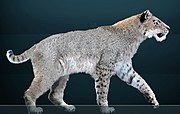 Restoration of Pliocene-Pleistocene Homotherium, or scimitar cat
Restoration of Pliocene-Pleistocene Homotherium, or scimitar cat- †
- †Homotherium serum
- Hydrangea
- †
- †Hypohippus
- †Hypolagus
- †
- †
- †
- †
- †
I[]
- Ilex
 Foliage and fruit of a living Ilex, or holly
Foliage and fruit of a living Ilex, or holly- †
J[]
- Juglans
- †
L[]
- Larix
- †
- † – type locality for species
- Lasiurus
 A living Lasiurus, or hairy-tailed bat
A living Lasiurus, or hairy-tailed bat- †
- Lasius
- †Ledum
- † – type locality for species
- Lepus
- Libocedrus
- †
- †Limnephilus
- †Liriodendron
- †
- †Lithocarpus
- †
- Lontra
- †Lontra canadensis
- †Lontra weiri – type locality for species
- Lynx
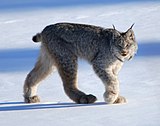 A living Lynx
A living Lynx- †Lynx canadensis
- †Lynx rufus
M[]
- †Macrophya
- † – type locality for species
- Mahonia
- †
- †
- †
- †Mammut
- †Mammut americanum
- †Mammuthus
- †Mammuthus columbi
 Life restoration of a herd of Mammuthus columbi, or Columbian mammoths. The extent of the fur depicted is hypothetical. Charles R. Knight (1909).
Life restoration of a herd of Mammuthus columbi, or Columbian mammoths. The extent of the fur depicted is hypothetical. Charles R. Knight (1909). - †
- †
- †Megacamelus
- †Megaleuctra
- † – type locality for species
- †Megalonyx
- †Megalonyx jeffersonii
- †Megalonyx leptostomus
- †Megantereon
- †
- Meleagris
- †Meleagris gallopavo
- Mergus
- †Mergus merganser
- †Merychyus
- †
- †
- †Mesoreodon
- †
- Messor – tentative report
- †Metalopex
- †
- Metasequoia
- †Michenia
-
- †
- †Mimomys
- †Miohippus
 Fossilized skull of the Eocene-Oligocene three-toed horse Miohippus
Fossilized skull of the Eocene-Oligocene three-toed horse Miohippus- † – or unidentified comparable form
- † – tentative report
- †
- Mustela
- †
N[]
- Natrix
- † – type locality for species
- Neophrontops
 Mounted fossilized skeleton of the Miocene Neophrontops
Mounted fossilized skeleton of the Miocene Neophrontops- † – type locality for species
- Neotoma
- † – or unidentified comparable form
- †
- † – type locality for species
- †Niglarodon
- †
- †
- †
- †
- †Nyssa
- †
O[]
- Odocoileus
 A living Odocoileus deer
A living Odocoileus deer - Ondatra
- † – type locality for species
- †
- †Ondatra zibethicus
- †
- † – type locality for species
- †
- †
- †
- † – or unidentified comparable form
- †
- †Osmunda
- †
- †
- Ostrya
- †
- †Oxydactylus
 Mounted fossilized skeleton of the Oligocene-Miocene camel Oxydactylus
Mounted fossilized skeleton of the Oligocene-Miocene camel Oxydactylus
P[]
- †
- †
- †Paenemarmota
- †
- †
- †Palaeolagus – tentative report
- Panthera
- †Panthera leo
- †
- †
- †
- †
- †Paramylodon

- †Paramylodon harlani
- † – type locality for genus
- † – type locality for species
- †Parthenocissus
- †
- Pelecanus
- †Pelecanus halieus – type locality for species
- Perognathus
- † – type locality for species
- Peromyscus
- † – type locality for species
- Persea
- †
- Phalacrocorax
- †Phalacrocorax auritus
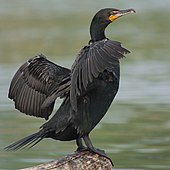 A living Phalacrocorax auritus, or double-crested cormorant
A living Phalacrocorax auritus, or double-crested cormorant - †
- † – type locality for species
- Phenacomys
- †
- Phryganea
- Picea
- †
- †
- †
- †
- Pinus
- †
- † – type locality for species
- †
- †
- † – type locality for species
- †
- Platanus
- † – type locality for species
- †Platygonus
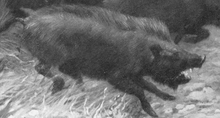 Restoration of a herd of alarmed Miocene-Pleistocene peccaries of the genus Platygonus. Charles R. Knight (1922).
Restoration of a herd of alarmed Miocene-Pleistocene peccaries of the genus Platygonus. Charles R. Knight (1922).- † – type locality for species
- †
- † – or unidentified comparable form
- †
- † – type locality for species
- †
- †
- †
- †
- †
- † – or unidentified comparable form
- Populus
- †
- †
- Porzana
- † – type locality for species
- †Potamogeton
- †
- †
- †
- †Procastoroides
- †
- †
- Procyon
- †Procyon lotor
- †
- † – type locality for species
- †Promerycochoerus
 Restoration of the Miocene hippopotamus-like oreodont Promerycochoerus both onshore and in the water. Robert Bruce Horsfall (1913).
Restoration of the Miocene hippopotamus-like oreodont Promerycochoerus both onshore and in the water. Robert Bruce Horsfall (1913).- †
- †
- † – type locality for species
- †Protolabis
- Prunus
- †
- †
- † – type locality for genus
- † – type locality for species
- †Pseudolarix
- †Pseudolarix americana
- †
- †Pseudotsuga
- †
- †
- Pterocarya
- †
- Puma
- †Puma concolor
Q[]
- Quercus
 A living Quercus, or oak tree
A living Quercus, or oak tree- † – type locality for species
- † – type locality for species
- †
- † – type locality for species
- †
- † – type locality for species
- †
- † – type locality for species
- Querquedula
R[]
- Rangifer
- †Rangifer tarandus
- †Rhamnus
- †
- Rhododendron
- †
- Rhus
- †
- †Rhynchotherium
 Restoration of the Miocene-Pliocene elephant relative Rhynchotherium
Restoration of the Miocene-Pliocene elephant relative Rhynchotherium - †Ribes
- Rosa
- †
- †Rymosia
- † – type locality for species
S[]
- Salix
- †
- †
- †
- † – type locality for species
- Sassafras
- †
- †
- †Satherium
- Scapanus
- † – type locality for species
- † – or unidentified comparable form
- †Scapanus townsendii – or unidentified related form
- Sciara
- † – type locality for species
- Sequoia
- †Sequoiadendron
- †Simocyon
- † – or unidentified comparable form
- †Smilax
- † – or unidentified comparable form
- †Smilodon
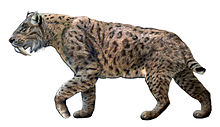 Life restoration of the Pleistocene-Holocene saber-tooth cat Smilodon
Life restoration of the Pleistocene-Holocene saber-tooth cat Smilodon- †Smilodon fatalis
- †
- † – type locality for species
- †Sophora
- †
- †Sorbus
- †
- †
- Sorex
- † – type locality for species
- † – type locality for species
- †Sorex palustris
- † – type locality for species
- † – or unidentified comparable form
- Spermophilus
- †
- Sphecophaga – tentative report
- †Spiraea
- † – type locality for species
- †StegomastodonMounted fossilized skeleton of the Pliocene-Pleistocene elephant relative Stegomastodon
- †Stegomastodon mirificus
- Sthenictis
- Sylvicola
- † – type locality for species
- †Symphoricarpos
- †
- †
T[]
- Taxidea
- †Taxidea taxus
- Taxodium
- †Teleoceras
 Restoration of the Miocene-Pliocene rhinoceros Teleoceras
Restoration of the Miocene-Pliocene rhinoceros Teleoceras - Thamnophis
- Thomomys
- †
- †Thomomys townsendii
- †Thuja
- †
- †Ticholeptus
- †
- Tilia
- †
- †
- †Trigonictis
- †
- †
- †Tsuga
- †
- Typha
- †
U[]
- Ulmus
 A living Ulmus, or elm
A living Ulmus, or elm- †
- †
- †
- †
- †Ungnadia
- †
- Ursus
- †Ursus abstrusus – type locality for species
V[]
- †Vaccinium
 A variety of modern Vaccinium species, clockwise from top right: cranberries, lingonberries, blueberries, and huckleberries
A variety of modern Vaccinium species, clockwise from top right: cranberries, lingonberries, blueberries, and huckleberries- †
- †Vauquelinia
- Vulpes
- †Vulpes vulpes
Z[]
- Zelkova
- †
- †
References[]
- Various Contributors to the Paleobiology Database. "Fossilworks: Gateway to the Paleobiology Database". Retrieved 17 December 2021.
{{cite web}}:|author=has generic name (help)
Categories:
- Paleontology in Idaho
- Cenozoic Idaho
- Lists of the Cenozoic life of the United States by state






























